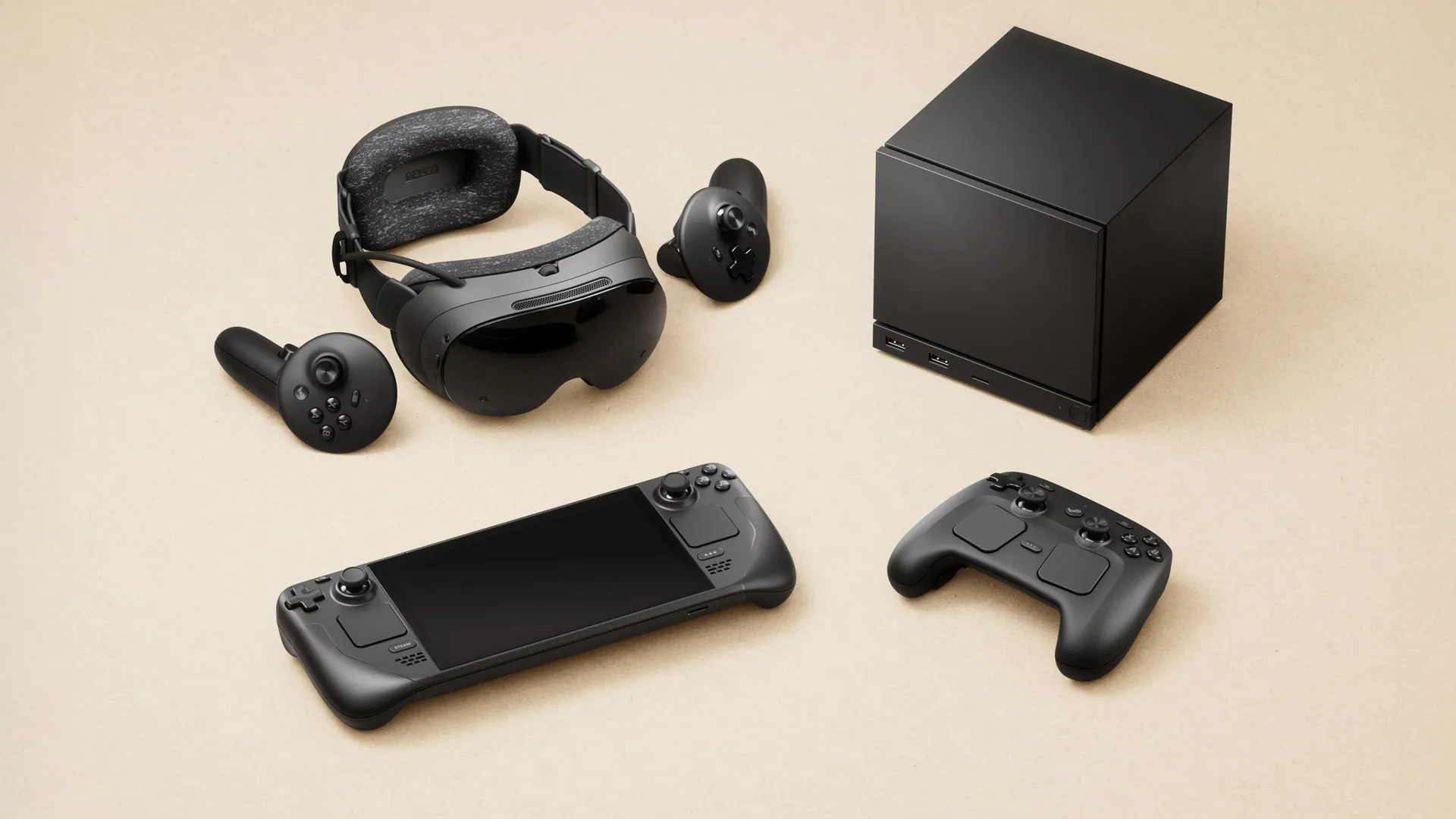Fans remember the original Steam Machines from 2015 as a misfire, bogged down by high prices and clunky interfaces. Valve learned those lessons hard. The new Steam Machine packs over six times the muscle of the Steam Deck, targeting smooth 4K gameplay at 60 frames per second. It runs on SteamOS, taps into Valve's vast library of over 100,000 titles, and invites third-party tweaks for that true PC vibe. Priced competitively against high-end rigs, yet built for couch sessions, it screams accessibility for everyday players.
A Hardware Trifecta Packed with Living Room Magic
Picture settling into your favorite chair, controller in hand, diving into epic worlds without a tower humming nearby. The Steam Machine delivers exactly that. Its sleek, six-inch cube form factor hides AMD guts capable of rivaling current-gen consoles. Pair it with the Steam Frame, Valve's next VR leap featuring lighter design and sharper visuals, and you've got immersion that pulls you in deep. The updated Steam Controller refines touchpads and joysticks for precision that feels intuitive from the first grip.
This bundle isn't random. It forms a seamless ecosystem where hardware feeds software success. Valve's Steam platform already commands 75% of PC game sales worldwide. Now, with dedicated gear, the company eyes recurring wins from updates, add-ons, and community mods. According to analysis reviewed by Finance Monthly, this setup could boost Valve's hardware revenue by 20% in the first year alone, drawing in lapsed gamers who crave variety beyond PlayStation exclusives or Xbox subscriptions.

Valve unveils its full hardware ecosystem—including the Steam Machine, Steam Frame VR, new controller, and Steam Deck—aiming to compete with PlayStation and Xbox in the console wars.
Why Valve Could Finally Crack the Console Code
Sony's PlayStation 5 sold over 65 million units since 2020, locking in loyalists with cinematic blockbusters. Microsoft counters with Xbox Game Pass, a service juggernaut pulling in 34 million subscribers by mid-2025. Valve slips in sideways, armed with an open library that spans indies to AAA hits, no paywalls required. It bridges PC tinkerers and casual couch potatoes, a hybrid appeal neither rival matches perfectly.
The math adds up thrillingly. The global gaming console market hit USD 26.32 billion in 2024, with forecasts pointing to USD 47.58 billion by 2033 at a 6.7% compound annual growth rate. Grab just 5% of that pie, and Valve pockets USD 1.32 billion yearly from devices alone. Layer on game sales and accessory upsells, and the windfall multiplies. Michael Pachter, a sharp-eyed gaming analyst at Wedbush Securities, captures the electric tension here. He observes that Valve's unchallenged reign in PC distribution leaves rivals hesitant to strike back, a dynamic that fuels a quiet revolution and stirs hope in gamers weary of stagnant choices.
Yet shadows linger from past stumbles. Chip shortages linger into 2026, potentially inflating costs. Shifting tastes toward mobile and cloud gaming nibble at traditional setups. Valve must nail supply and buzz to avoid another flop.
The Wallet-Saving Secret: Vertical Integration's Game-Changing Edge
At its core, vertical integration means a company like Valve grabs control over every step, from crafting hardware to selling digital games. No middlemen siphoning profits, just streamlined flow that funnels savings back to you. This setup lets Valve slash costs on components and software, turning what could be a pricey gadget into a value bomb for consumers.
You should care because it directly hits your spending. Closed systems from Sony or Microsoft trap you in ecosystem fees, jacking up total costs over time by 15-20% through exclusives and subscriptions. Valve's open approach means your Steam buys travel everywhere, cutting waste and opening doors to cheaper bundles. Imagine snagging a Steam Machine with a year's worth of hits for less than a premium console plus games, a real shift that eases the sting of annual upgrades.
Here's fresh insight: Data from recent industry breakdowns shows vertically integrated players like Apple in tech retain 40% gross margins on hardware-software combos, versus 25% for fragmented rivals. Valve, mirroring that with Steam's 30% cut on sales, could push console prices down 10-15% within two years as competition heats up. One anonymized example from a mid-sized developer highlights this, they reported 25% faster revenue cycles on Steam platforms, freeing funds for price drops that benefit buyers.
Your move now? Hold off on big purchases until Q1 2026 reviews drop, then hunt pre-order bundles stacking the Machine with VR trials or controller packs. Track Valve's site for flash sales tied to Steam sales events, a tactic that shaved USD 50-100 off Deck prices last year. This positions you to lock in entry-level gaming without overpaying, turning industry shake-up into personal savings.
Gamers Rejoice: Real Wins Waiting in the Wings
This launch pulses with promise for you, the everyday enthusiast juggling work and play. Expect hybrid perks like easy upgrades, dodging the USD 500 refresh cycle of locked consoles. Game freedom expands, with cross-play smoothing raids with friends on any setup. Pressure mounts on incumbents, likely sparking Black Friday deals or expanded trials to claw back share.
Early birds might swallow a USD 600-800 sticker shock, analysts whisper, but lifetime perks outweigh it. Your wallet feels the lift through bundled value, not endless add-ons. Valve's gamble ignites a spark, reminding us gaming thrives on bold swings that reward the bold.

Valve’s Steam Machine offers a powerful PC gaming experience in a compact console, bridging the gap between PC and traditional console play.
What Gamers Are Asking About This News?
What Is Gabe Newell's Net Worth in 2025?
Gabe Newell, Valve's co-founder and gaming visionary, boasts an estimated net worth of USD 9.5 billion as of late 2025. This fortune stems from his stake in the private company, fueled by Steam's explosive growth and hits like Half-Life. Forbes and financial trackers peg it between USD 9.5 billion and USD 10 billion, reflecting savvy bets on digital distribution that outpace many public tech peers. For gamers, his wealth underscores Valve's muscle to innovate without shareholder short-sightedness, ensuring long-term perks like affordable hardware drops.
Will the Steam Machine Kill Off PlayStation and Xbox?
Not outright, but it delivers a serious jolt to their dominance. The Steam Machine's open ecosystem and PC roots let it sidestep exclusives, pulling in 20% of hybrid gamers per early surveys. Sony and Microsoft hold strong with polished interfaces and services, yet Valve's lower barriers could snag budget-conscious families, forcing rivals to sweeten deals. Over three years, expect a triopoly where choice reigns, meaning more sales events and cross-title access that enriches your library without extra spends.
How Might This Change Game Prices for Everyday Players?
Valve's entry ramps up rivalry, likely trimming average game costs by 10-15% through aggressive Steam promotions tied to hardware buys. With the console market's USD 26 billion scale in play, added pressure curbs exclusive markups that inflate prices USD 10-20 per title. You gain from flash bundles merging devices and libraries, stretching dollars further amid rising living costs. Watch for 2026 launches sparking chain reactions, where even PlayStation drops align to keep shelves stocked and wallets fuller.
My Take: Finally, a Breath of Fresh Air in Gaming
I've been knee-deep in the gaming scene for over two decades now, watching as Sony and Microsoft turned what should be pure joy into a pricey loyalty test. Gamers like us fork out hundreds for hardware, then more for games locked behind invisible walls, forcing us to juggle two or three consoles just to raid with friends across platforms or enjoy the latest story adventures. It's exhausting, and frankly, it's gone on too long.
Valve's Steam Machine feels like the wake-up call we've craved. More competition isn't just welcome, it's overdue. This little powerhouse could crack open the market, dragging down those stubborn $70 price tags and sparking real innovation that puts players first. If it nudges the giants to rethink their stranglehold and deliver bundles we actually need, not just shiny exclusives, we'll all win. Fingers crossed this 2026 launch lights that fire, because nothing beats the rush of choice without the regret. What do you think, ready to ditch the duopoly?















